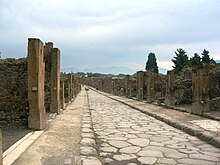 |
| UNESCO World Heritage Site |
|---|
The Archaeological excavation of Pompeii unearthed the ancient city of Pompeii at Civita hill, near the modern Pompeii. The ancient city was buried under layers of ash and lapilli during the Eruption of Mount Vesuvius in 79 AD, along with Herculaneum, Stabiae, and Oplontis[1].
The discovery, initiated by the will of Charles III of Spain, shows one of the best-preserved testimony of Roman life[2], as well as the best preserved city of that era.
Most of the archaeological finds recovered (in addition to simple furnishings of everyday use, frescoes, mosaics, and statues) are preserved in the National Archaeological Museum of Naples, while a smaller portion is in the Antiquarium of Pompeii[3]. The prominent quantity of the discovery was useful in undertanding customs, traditions, dietary habits, and art of more than two millennia ago.
In 2023, 3,985,424 tourists visited the excavation of Pompeii[4]. In 1997, in order to preserve the integrity of the ruins, which were managed by the Archaeological Park of Pompeii, along with the ones of Herculaneum and Oplontis, became part of the Lists of World Heritage Sites of UNESCO[5].

[[Category:World Heritage Sites in Italy]] [[Category:Pompeii (ancient city)]]
- ^ (Rinaldi Tufo & p. 9).
- ^ (Giuntoli & p. 7).
- ^ Giuntoli, p. 12.
- ^ "Dati visitatori". Retrieved .
{{cite web}}: Check date values in:|access-date=(help); line feed character in|access-date=at position 1022 (help) - ^ "Scheda dell'UNESCO". Retrieved 16 January 2012.